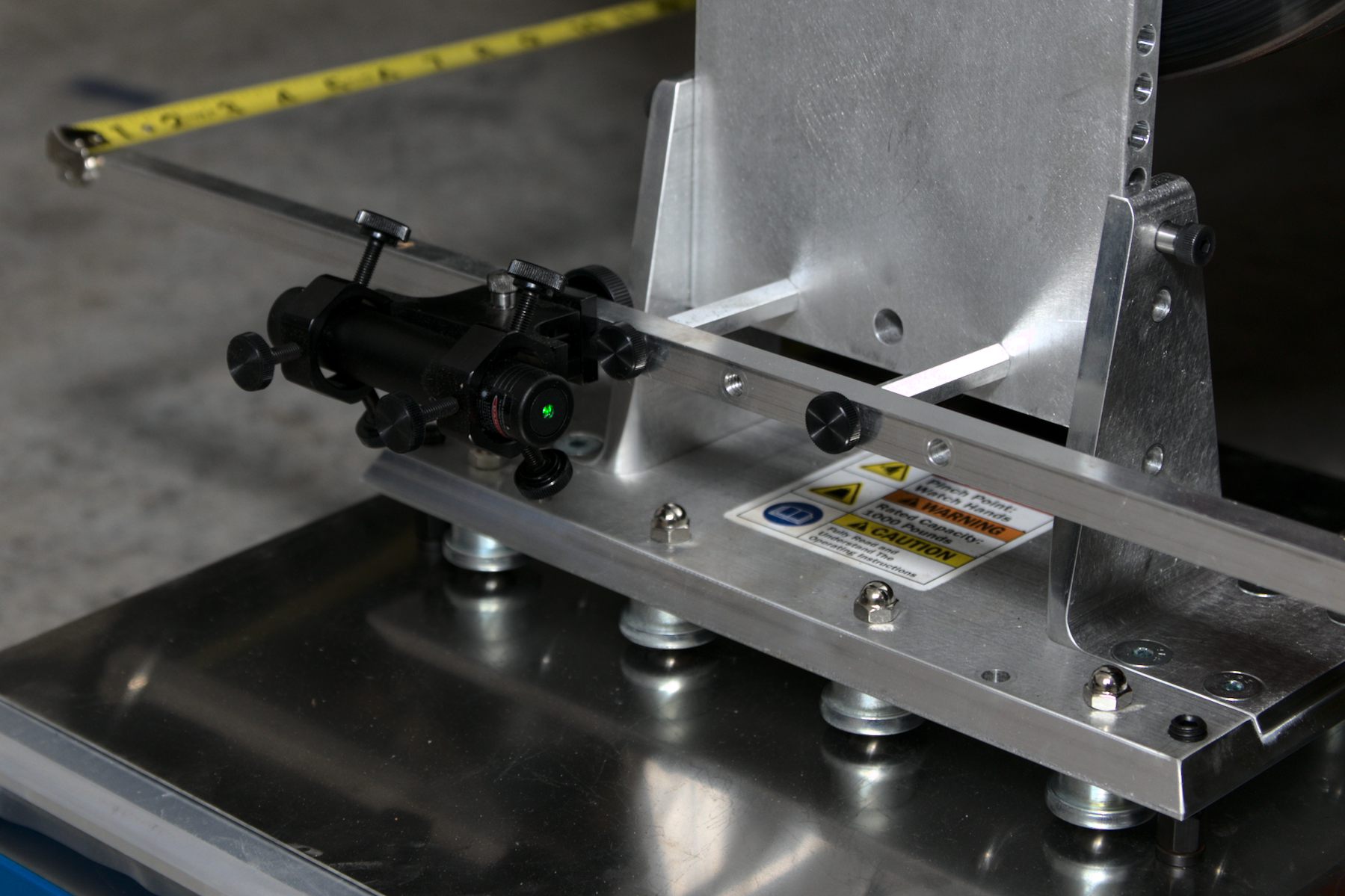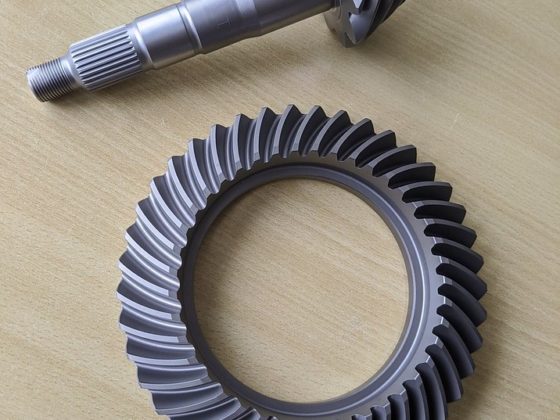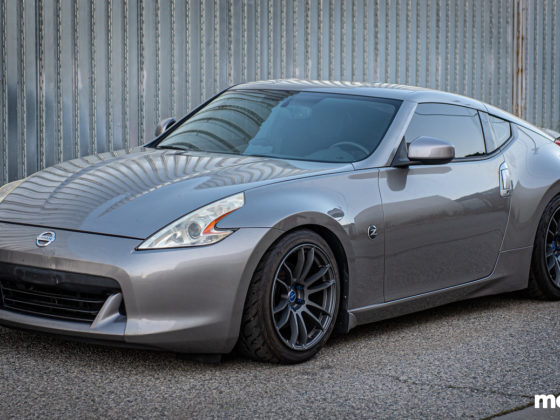
It comes with this adjustable laser and three height meters that have integrated bubble levels. It also comes with red eyeglasses so that you don’t blind yourself with the laser. You have to be able to see the laser on the height meter, so you’ll be putting the glasses on and off (for safety) as you make your adjustments.
How does it work? Glad you asked. I’ll show you.

The laser sits on one of the scales and then shines its beam towards the other three, hitting the height meter.
There is a little bit of a chicken-and-egg dance that goes on when setting up the scale pads. You actually want to put your car on the scales first, and then take it off. Why? Because this tells you where to actually place the scales and their leveling pads. Once the car is off, you can then use the laser to level the pads. Then you can mark the floor, take everything away, bring the car back in, jack it up again, put the leveled pads back on the marks, and then drop the car on the pads. Whew!
They do make really fancy drive-on rigs so that you don’t have to do this dance. The fancy drive-on platform would be even more ultimate. That level of fancy ultimate means expensive, and I was already head-first and ankles-deep into everything motorsports, so I skipped that expense… for now.

Get the laser pointed at one of the height meters, adjust the pad’s height, check the level on the pad, and repeat until you are on the zero. Go to the next pad and repeat the process. Lastly, exchange the laser with one of the other pads and point it back at where it came and make sure it’s still zeroed.
The instructions say to make sure that the laser is on the “highest” pad and that you bring the others up.

I triple checked with both a standard level (you can see this in one of the other pictures) as well as a small portable digital bubble level (not shown), but I found that the “dumb” bubble level is actually pretty darned accurate. The digital level typically only reported fractional (less than one) degree out-of-level when I eyeballed the bubble.




17 comments
palate / palette / pallet. Your “palate” is the roof of your mouth, and by extension, your sense of taste. A “palette” is the flat board an artist mixes paint on (or by extension, a range of colors). A “pallet” is either a bed (now rare) or a flat platform onto which goods are loaded.May 30, 2016
palate / palette / pallet | Common Errors in English Usage and …
brians.wsu.edu › 2016/05/30 › palate-palette-pallet
loaded
It’s funny – I looked at the spelling several times and was questioning it in my mind and didn’t bother to look it up. Thanks – I will go fix it 🙂
A fantastic article overall, too many years doing newspaper and yearbook edits make me notice things like that. Can’t wait to see the car driven in anger.
@DedBull I am always down for constructive/useful criticism. Good eye and thanks for catching it.
Next event is hopefully September 11th!
I really want this for Christmas!
@mike it’s frustrating at first but now that I am learning how to do everything it’s becoming more enjoyable. Especially now that it’s all dialed in. I have probably re-done the same thing three or four times, and I probably have a few more re-dos still to go.
Any chance of a full list of part numbers?
@atomic I added part numbers to the very last page just now. Good idea and thanks for asking for it.
I love this! Thanks for sharing.
Very impressive set-up. A question regarding the weight in the driver’s seat: for when you are corner weighing the vehicle, why not put some weight on the floor where your feet will be? You are clearly going to great lengths to maximize a lot of the systems on this car, so why not go this extra mile? Put a bathroom scale on the floor as far forward as the pedals/bulkhead will allow, sit in your normal driving position and read the scale to determine how much of your weight is not on your seat. Then, you can put some weight on the floor and put the rest in the seat. Necessary? No, but it’s more accurate than putting all of the weight in the seat. Just a suggestion.
@banfstc you are correct. I had sent that picture to a buddy who does drag car chassis set up (Menscer Motorsports) and he more or less immediately made the same comment. Since that photo I have been putting one of the 45# plates on the floor just in front of the seat. Ideally I need to get additional small weights to do as you suggest — “lay” my weight out more realistically where it goes. That being said, my guess is that my feet by the pedals weigh on the order of 20# at most as I sit pretty deep in the seat. I’d be curious to see what moving 20# from the seat to the pedal box area will do to the corner weights. At some point I’ll report back on that for sure!
Only half kidding. I am local and setting up my Lotus Esprit for track day fun. Adding lots of adjust ability to the suspension.
Would you let me come by and guide me while I corner weight and align the car with your awesome gear?
Happy to pay for the privilege. I realize it would probably take much of a day and it is a big ask.
If you use Facebook, send me a message. Happy to talk about it. One requirement is that your car needs to be 5-lug. If it’s not, it won’t work (I only have the 5-lug plate). If you don’t use Facebook you can email me using my full name (Erik M Jacobs) to Gmail
I’m always so confused by the enormous amount of time and money spent on this car. At this point, you’ve spent so much money on everything from overkill wiring to now pro-level alignment gear, you could have just bought a better starting point that didn’t need all this work. You’d also have more time behind the wheel where most of your lap time will come from. It’s a very thorough and impressive build, but it just doesn’t seem like the wisest route to a lap time.
@hayes
The journey is not about the destination.
I could have bought an MX5 global cup car. I could have bought a used TA2. I could’ve bought a used Porsche or sorted PCA or other race car. This is a horrifically expensive build.
Why? Why not?
I wouldn’t have learned anything about wiring, fabrication, or building cars. I wouldn’t have had any of the experiences I’ve had in the building of it.
Realizing your dream isn’t always about the end result. Sometimes it’s about the things that go into realizing the dream. Sometimes the dream itself loses its importance along the way, and it becomes all about the way and not the dream.
If I had a dollar for every time I wanted to set this car on fire and give up, I’d have lots of dollars. You don’t see the heartbreak or the misery parts on MotoIQ. You get the happy bits at the end of figuring it out. Sometimes you see the un-fun things, but it would be really quite boring.
I’m not much for the whole #builtnotbought movement, but there’s something to it. I often wish I could just send the car somewhere, stroke a check, and have it be a GT4-like end product.
But that’s not what’s happened. And I wouldn’t have it any other way.
So if I have a welded diff, this doesn’t work, right?
@nikita yeah it would be nearly impossible to get the lugs lined up so that the hub stands would both be vertical. You definitely need a diff that has SOME level of independent movement, or you would need to come up with an alternate mounting stand where you could attach something to the hub and then be able to rotate the actual stand to be in the proper orientation. It would be….. hard.